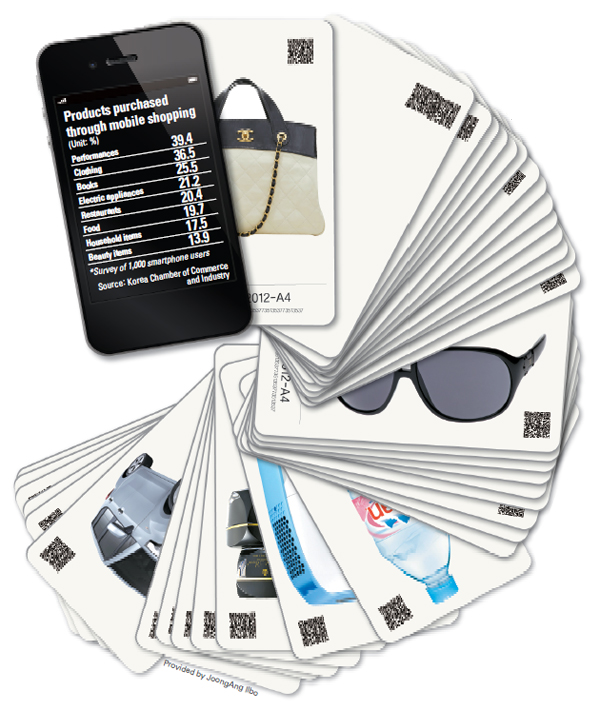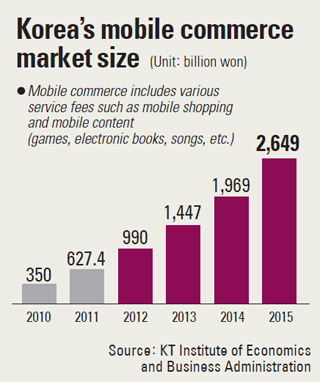Smartphone shopping the new buzz

The morning subway to work is filled with people in business suits, student garb and other modes of dress. Even in the tight space, they manage to pull out smartphones and entertain themselves.
Some are playing games, some are browsing Internet blogs or the news. But more and more, people can be seen browsing Internet shopping malls on their phones. A few sly peeks at fellow commuters will show screens displaying everything from groceries to movie tickets.
In Korea, one in every two cell phones is a smartphone. Of the many ways the devices are changing Korean’s lives, the mobile shopping industry is one of the biggest.

Location-based services (LBS) and extensive product databases provide more accurate and relevant information for mobile shoppers. It’s there constantly. You can access it whenever you have a spare moment.
These so-called “smart shoppers” are basically a new type of shopper. For Sohn Na-gyeong, 29, her grocery shopping is done twice or three times a week, not in local stores but in the subway on the way to work.
She connects to an online supermarket and purchases household items such as bottled water to be delivered to her residence when she returns from work that evening. Sohn mentions that the convenience of the delivery of heavy objects, such as bottled water, is a blessing after a tiring day.
The Chamber of Commerce and Industry conducted a study at the end of last year on 1,000 smartphone users regarding their use of mobile shopping.
The results showed that 14 percent utilized their mobile devices to purchase products and half of the total users said they used their smartphones to receive information on products before purchasing them in person or on the Internet.
The study also showed that “smart shoppers” were mostly in their 20s and 30s, not in their 40s or beyond. The most frequently purchased items were tickets for various events, such as performances, movies and plays, making up 39 percent of mobile shopping transactions. Meanwhile, clothing followed with 37 percent and books came third, making up 26 percent of mobile purchases.
According to Go Yoon-jeon, KT Institute of Economics and Business Administration’s director of marketing strategy, “The reason there are a lot of mobile shopping users in their 20s and 30s is because for them, the smartphone contributes to their work as well as leisure.”
As the mobile shopping industry grows, companies are offering competitive services to “smart shoppers.” From Hyundai Home Shopping’s H Codi App, which allows customers to “try on” an accessory by seeing it on themselves via the cameras on their smartphones, to LG U+’s “DingDong,” which uses social networking sites for shoppers to exchange information on products, the competitors within the mobile shopping industry cannot be simply categorized as retail corporations or telecommunication companies.
As the industry grows, different kinds of competitors are arising to target consumers.
The limitation of convenient mobile shopping is being unable to touch or squeeze the product. For Parent’s Day, businesswoman Lim Han-sol used a 50 percent discount coupon offered by a social commerce Web site to purchase flowers for her parents, but ended up demanding a refund because the real bouquet didn’t measure up to its description online.
According to the Korea Consumer Agency’s survey of 1,000 social commerce users, or mobile shoppers that use shopping applications that work in conjunction with social networking sites, one in every 10 users had dissatisfaction with their purchased products. The greatest reason for dissatisfaction was the difference between the actual item and how it was advertised.
In addition, mobile shoppers felt a difference in customer service and actually felt that the service toward “smart shoppers” was unpleasant.
Keeping product descriptions consistent with the actual product isn’t the only hurdle mobile shopping must overcome. The comparatively smaller screens and slower Internet speeds on smartphones, as well as secure payment options, are some of the largest challenges that the mobile shopping industry has yet to overcome.
Lee Dong-il, a professor of business administration, said that the public key certificate, which ensures that an individual’s private information will stay private and is based on Microsoft’s Active X for Internet transactions, may cause problems when used on smartphones due to compatibility issues.
Professor Lee stressed the need for not only product standardization, but also development of mobile-only screens and clear regulations on mobile advertisements.
By Yum Tae-jung [ebusiness@joongang.co.kr]










with the Korea JoongAng Daily
To write comments, please log in to one of the accounts.
Standards Board Policy (0/250자)